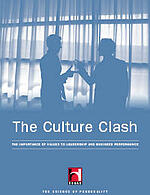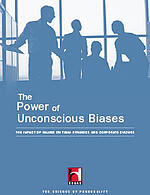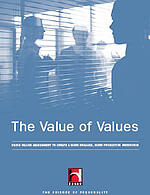 Are you getting ready to head home for Thanksgiving and wondering how successful your reunion at the local bar with friends will be? You’re in luck! Just in time, I have returned to provide the third and final installment of this series on the physical attractiveness of your personality. To bring you up to speed, you can read Part I and Part II. Part I revealed that people, in general, are perceived to be physically attractive when they are seen as friendly, attention-seeking, and altruistic networkers. In Part II we learned that the story changes a bit when we are judging the attractiveness of men and women separately.
Are you getting ready to head home for Thanksgiving and wondering how successful your reunion at the local bar with friends will be? You’re in luck! Just in time, I have returned to provide the third and final installment of this series on the physical attractiveness of your personality. To bring you up to speed, you can read Part I and Part II. Part I revealed that people, in general, are perceived to be physically attractive when they are seen as friendly, attention-seeking, and altruistic networkers. In Part II we learned that the story changes a bit when we are judging the attractiveness of men and women separately.
Specifically, women are found more attractive when they are charismatic, attention-seeking team players, while attractive men are unassuming team players. In this installment, we will be examining the pattern of results when separating the genders of both the target and the rater. Because of the complexity of these 2x2 analyses, I will start by providing a table that displays all of the significant predictors of physical attractiveness by target and rater, in descending order of predictive power. This should be particularly useful for those of you who speak Hoganese. You can also check out the Physically Attractive Profiles based on relationships between Hogan scores and ratings of physical attractiveness.
|
normal;">
|
mso-border-right-alt: solid windowtext .5pt; padding: 0in 5.4pt 0in 5.4pt;" valign="top">
normal;">
|
none; mso-border-left-alt: solid windowtext .5pt; mso-border-alt: solid windowtext .5pt;
padding: 0in 5.4pt 0in 5.4pt;" colspan="2" valign="top">
text-align: center; line-height: normal;" align="center">TARGET
|
mso-border-bottom-alt: solid windowtext .5pt; padding: 0in 5.4pt 0in 5.4pt;" valign="top">
normal;">
|
border-right: solid windowtext 1.0pt; mso-border-bottom-alt: solid windowtext .5pt;
mso-border-right-alt: solid windowtext .5pt; padding: 0in 5.4pt 0in 5.4pt;" valign="top">
normal;">
|
border-right: solid windowtext 1.0pt; mso-border-top-alt: solid windowtext .5pt;
mso-border-left-alt: solid windowtext .5pt; mso-border-alt: solid windowtext .5pt;
padding: 0in 5.4pt 0in 5.4pt;" valign="top">
text-align: center; line-height: normal;" align="center">MALE
|
mso-border-left-alt: solid windowtext .5pt; mso-border-alt: solid windowtext .5pt;
padding: 0in 5.4pt 0in 5.4pt;" valign="top">
text-align: center; line-height: normal;" align="center">FEMALE
|
mso-border-top-alt: solid windowtext .5pt; mso-border-alt: solid windowtext .5pt;
padding: 0in 5.4pt 0in 5.4pt;" rowspan="20">
text-align: center; line-height: normal;" align="center">RATER
|
border-right: solid windowtext 1.0pt; mso-border-top-alt: solid windowtext .5pt;
mso-border-left-alt: solid windowtext .5pt; mso-border-alt: solid windowtext .5pt;
padding: 0in 5.4pt 0in 5.4pt;" rowspan="13">
text-align: center; line-height: normal;" align="center">MALE
|
border-right: solid windowtext 1.0pt; mso-border-top-alt: solid windowtext .5pt;
mso-border-left-alt: solid windowtext .5pt; mso-border-alt: solid windowtext .5pt;
padding: 0in 5.4pt 0in 5.4pt;" valign="top">
normal;">Aesthetics
|
border-right: solid windowtext 1.0pt; mso-border-top-alt: solid windowtext .5pt;
mso-border-left-alt: solid windowtext .5pt; mso-border-alt: solid windowtext .5pt;
padding: 0in 5.4pt 0in 5.4pt;" valign="top">
normal;">Altruistic
|
border-right: solid windowtext 1.0pt; mso-border-top-alt: solid windowtext .5pt;
mso-border-left-alt: solid windowtext .5pt; mso-border-alt: solid windowtext .5pt;
padding: 0in 5.4pt 0in 5.4pt;" valign="top">
normal;">Reserved (-)
|
border-right: solid windowtext 1.0pt; mso-border-top-alt: solid windowtext .5pt;
mso-border-left-alt: solid windowtext .5pt; mso-border-alt: solid windowtext .5pt;
padding: 0in 5.4pt 0in 5.4pt;" valign="top">
normal;">Sociability
|
border-right: solid windowtext 1.0pt; mso-border-top-alt: solid windowtext .5pt;
mso-border-left-alt: solid windowtext .5pt; mso-border-alt: solid windowtext .5pt;
padding: 0in 5.4pt 0in 5.4pt;" valign="top">
normal;">Dutiful
|
border-right: solid windowtext 1.0pt; mso-border-top-alt: solid windowtext .5pt;
mso-border-left-alt: solid windowtext .5pt; mso-border-alt: solid windowtext .5pt;
padding: 0in 5.4pt 0in 5.4pt;" valign="top">
normal;">Ambition
|
border-right: solid windowtext 1.0pt; mso-border-top-alt: solid windowtext .5pt;
mso-border-left-alt: solid windowtext .5pt; mso-border-alt: solid windowtext .5pt;
padding: 0in 5.4pt 0in 5.4pt;" valign="top">
normal;">Diligent (-)
|
border-right: solid windowtext 1.0pt; mso-border-top-alt: solid windowtext .5pt;
mso-border-left-alt: solid windowtext .5pt; mso-border-alt: solid windowtext .5pt;
padding: 0in 5.4pt 0in 5.4pt;" valign="top">
normal;">
|
border-right: solid windowtext 1.0pt; mso-border-top-alt: solid windowtext .5pt;
mso-border-left-alt: solid windowtext .5pt; mso-border-alt: solid windowtext .5pt;
padding: 0in 5.4pt 0in 5.4pt;" valign="top">
normal;">Skeptical (-)
|
border-right: solid windowtext 1.0pt; mso-border-top-alt: solid windowtext .5pt;
mso-border-left-alt: solid windowtext .5pt; mso-border-alt: solid windowtext .5pt;
padding: 0in 5.4pt 0in 5.4pt;" valign="top">
normal;">
|
border-right: solid windowtext 1.0pt; mso-border-top-alt: solid windowtext .5pt;
mso-border-left-alt: solid windowtext .5pt; mso-border-alt: solid windowtext .5pt;
padding: 0in 5.4pt 0in 5.4pt;" valign="top">
normal;">Leisurely (-)
|
border-right: solid windowtext 1.0pt; mso-border-top-alt: solid windowtext .5pt;
mso-border-left-alt: solid windowtext .5pt; mso-border-alt: solid windowtext .5pt;
padding: 0in 5.4pt 0in 5.4pt;" valign="top">
normal;">
|
border-right: solid windowtext 1.0pt; mso-border-top-alt: solid windowtext .5pt;
mso-border-left-alt: solid windowtext .5pt; mso-border-alt: solid windowtext .5pt;
padding: 0in 5.4pt 0in 5.4pt;" valign="top">
normal;">Sociability
|
border-right: solid windowtext 1.0pt; mso-border-top-alt: solid windowtext .5pt;
mso-border-left-alt: solid windowtext .5pt; mso-border-alt: solid windowtext .5pt;
padding: 0in 5.4pt 0in 5.4pt;" valign="top">
normal;">
|
border-right: solid windowtext 1.0pt; mso-border-top-alt: solid windowtext .5pt;
mso-border-left-alt: solid windowtext .5pt; mso-border-alt: solid windowtext .5pt;
padding: 0in 5.4pt 0in 5.4pt;" valign="top">
normal;">Affiliation
|
border-right: solid windowtext 1.0pt; mso-border-top-alt: solid windowtext .5pt;
mso-border-left-alt: solid windowtext .5pt; mso-border-alt: solid windowtext .5pt;
padding: 0in 5.4pt 0in 5.4pt;" valign="top">
normal;">
|
border-right: solid windowtext 1.0pt; mso-border-top-alt: solid windowtext .5pt;
mso-border-left-alt: solid windowtext .5pt; mso-border-alt: solid windowtext .5pt;
padding: 0in 5.4pt 0in 5.4pt;" valign="top">
normal;">Recognition
|
border-right: solid windowtext 1.0pt; mso-border-top-alt: solid windowtext .5pt;
mso-border-left-alt: solid windowtext .5pt; mso-border-alt: solid windowtext .5pt;
padding: 0in 5.4pt 0in 5.4pt;" valign="top">
normal;">
|
border-right: solid windowtext 1.0pt; mso-border-top-alt: solid windowtext .5pt;
mso-border-left-alt: solid windowtext .5pt; mso-border-alt: solid windowtext .5pt;
padding: 0in 5.4pt 0in 5.4pt;" valign="top">
normal;">Altruistic
|
border-right: solid windowtext 1.0pt; mso-border-top-alt: solid windowtext .5pt;
mso-border-left-alt: solid windowtext .5pt; mso-border-alt: solid windowtext .5pt;
padding: 0in 5.4pt 0in 5.4pt;" valign="top">
normal;">
|
border-right: solid windowtext 1.0pt; mso-border-top-alt: solid windowtext .5pt;
mso-border-left-alt: solid windowtext .5pt; mso-border-alt: solid windowtext .5pt;
padding: 0in 5.4pt 0in 5.4pt;" valign="top">
normal;">Commerce (-)
|
border-right: solid windowtext 1.0pt; mso-border-top-alt: solid windowtext .5pt;
mso-border-left-alt: solid windowtext .5pt; mso-border-alt: solid windowtext .5pt;
padding: 0in 5.4pt 0in 5.4pt;" valign="top">
normal;">
|
border-right: solid windowtext 1.0pt; mso-border-top-alt: solid windowtext .5pt;
mso-border-left-alt: solid windowtext .5pt; mso-border-alt: solid windowtext .5pt;
padding: 0in 5.4pt 0in 5.4pt;" valign="top">
normal;">Bold (-)
|
border-right: solid windowtext 1.0pt; mso-border-top-alt: solid windowtext .5pt;
mso-border-left-alt: solid windowtext .5pt; mso-border-alt: solid windowtext .5pt;
padding: 0in 5.4pt 0in 5.4pt;" valign="top">
normal;">
|
border-right: solid windowtext 1.0pt; mso-border-top-alt: solid windowtext .5pt;
mso-border-left-alt: solid windowtext .5pt; mso-border-alt: solid windowtext .5pt;
padding: 0in 5.4pt 0in 5.4pt;" valign="top">
normal;">Ambition
|
border-right: solid windowtext 1.0pt; mso-border-top-alt: solid windowtext .5pt;
mso-border-left-alt: solid windowtext .5pt; mso-border-alt: solid windowtext .5pt;
padding: 0in 5.4pt 0in 5.4pt;" valign="top">
normal;">
|
border-right: solid windowtext 1.0pt; mso-border-top-alt: solid windowtext .5pt;
mso-border-left-alt: solid windowtext .5pt; mso-border-alt: solid windowtext .5pt;
padding: 0in 5.4pt 0in 5.4pt;" rowspan="7">
text-align: center; line-height: normal;" align="center">FEMALE
|
border-right: solid windowtext 1.0pt; mso-border-top-alt: solid windowtext .5pt;
mso-border-left-alt: solid windowtext .5pt; mso-border-alt: solid windowtext .5pt;
padding: 0in 5.4pt 0in 5.4pt;" valign="top">
normal;">Skeptical (-)
|
border-right: solid windowtext 1.0pt; mso-border-top-alt: solid windowtext .5pt;
mso-border-left-alt: solid windowtext .5pt; mso-border-alt: solid windowtext .5pt;
padding: 0in 5.4pt 0in 5.4pt;" valign="top">
normal;">Int. Sensitivity
|
border-right: solid windowtext 1.0pt; mso-border-top-alt: solid windowtext .5pt;
mso-border-left-alt: solid windowtext .5pt; mso-border-alt: solid windowtext .5pt;
padding: 0in 5.4pt 0in 5.4pt;" valign="top">
normal;">Excitable (-)
|
border-right: solid windowtext 1.0pt; mso-border-top-alt: solid windowtext .5pt;
mso-border-left-alt: solid windowtext .5pt; mso-border-alt: solid windowtext .5pt;
padding: 0in 5.4pt 0in 5.4pt;" valign="top">
normal;">Affiliation
|
border-right: solid windowtext 1.0pt; mso-border-top-alt: solid windowtext .5pt;
mso-border-left-alt: solid windowtext .5pt; mso-border-alt: solid windowtext .5pt;
padding: 0in 5.4pt 0in 5.4pt;" valign="top">
normal;">Hedonism (-)
|
border-right: solid windowtext 1.0pt; mso-border-top-alt: solid windowtext .5pt;
mso-border-left-alt: solid windowtext .5pt; mso-border-alt: solid windowtext .5pt;
padding: 0in 5.4pt 0in 5.4pt;" valign="top">
normal;">Leisurely (-)
|
border-right: solid windowtext 1.0pt; mso-border-top-alt: solid windowtext .5pt;
mso-border-left-alt: solid windowtext .5pt; mso-border-alt: solid windowtext .5pt;
padding: 0in 5.4pt 0in 5.4pt;" valign="top">
normal;">
|
border-right: solid windowtext 1.0pt; mso-border-top-alt: solid windowtext .5pt;
mso-border-left-alt: solid windowtext .5pt; mso-border-alt: solid windowtext .5pt;
padding: 0in 5.4pt 0in 5.4pt;" valign="top">
normal;">Reserved (-)
|
border-right: solid windowtext 1.0pt; mso-border-top-alt: solid windowtext .5pt;
mso-border-left-alt: solid windowtext .5pt; mso-border-alt: solid windowtext .5pt;
padding: 0in 5.4pt 0in 5.4pt;" valign="top">
normal;">
|
border-right: solid windowtext 1.0pt; mso-border-top-alt: solid windowtext .5pt;
mso-border-left-alt: solid windowtext .5pt; mso-border-alt: solid windowtext .5pt;
padding: 0in 5.4pt 0in 5.4pt;" valign="top">
normal;">Lrng. Approach (-)
|
border-right: solid windowtext 1.0pt; mso-border-top-alt: solid windowtext .5pt;
mso-border-left-alt: solid windowtext .5pt; mso-border-alt: solid windowtext .5pt;
padding: 0in 5.4pt 0in 5.4pt;" valign="top">
normal;">
|
border-right: solid windowtext 1.0pt; mso-border-top-alt: solid windowtext .5pt;
mso-border-left-alt: solid windowtext .5pt; mso-border-alt: solid windowtext .5pt;
padding: 0in 5.4pt 0in 5.4pt;" valign="top">
normal;">Cautious (-)
|
border-right: solid windowtext 1.0pt; mso-border-top-alt: solid windowtext .5pt;
mso-border-left-alt: solid windowtext .5pt; mso-border-alt: solid windowtext .5pt;
padding: 0in 5.4pt 0in 5.4pt;" valign="top">
normal;">
|
border-right: solid windowtext 1.0pt; mso-border-top-alt: solid windowtext .5pt;
mso-border-left-alt: solid windowtext .5pt; mso-border-alt: solid windowtext .5pt;
padding: 0in 5.4pt 0in 5.4pt;" valign="top">
normal;">Colorful
|
Once again, there is an overall finding worth note. Far and away, personality has a much stronger relationship with physical attractiveness when we are evaluating the same sex than when judging the opposite sex. There were twenty significant predictors (scales) related to physical attractiveness in same-sex pairings (males rating males and females rating females), but only six for opposite-sex pairings. As we get further into the specific gender pairings, it will become more apparent that the conclusions I have drawn in the past two parts of this series were being primarily driven by this stronger role of personality in same-sex pairings. If it is true that personality predicts attractiveness less in opposite-sex pairings and if we presume that the majority of this sample is heterosexual, as is found in the general population, these results may indicate that we tend to largely separate looks from personality when evaluating potential mates. When evaluating the attractiveness of peers, personality plays a much greater role. Does this mean that we can be more objective about the physical attractiveness of potential mates than of gender peers? It would be interesting to see if this pattern is replicated within an exclusively homosexual population – is it a gender or “love” effect?
Now let’s get into what makes men appear more attractive. There was only one characteristic that men and women agreed upon when it came to evaluating men; they both don’t care for the cynical, mistrusting types (a negative correlation for HDS Skeptical). Trust is apparently an important characteristic in determining the attractiveness of men, which makes particular sense for a woman who will find it unattractive when a man constantly doubts her intentions and actions. But how do we reconcile that people tend to find females more attractive when they are more mischievous in nature (as revealed in Part 2)? So we are more attracted to somewhat manipulative women who will keep us guessing, but then they don’t like it when we are skeptical of their ways? This is one interpretation but it could also be that the more unattractive parts of Skeptical turning both men and women off are the tendencies to be critical and argumentative, and it is clear to see the reasons for that. What is also interesting is that Skeptical has almost no relationship with attractiveness in women, regardless of who is evaluating them. We are tolerant of criticism, cynicism, and mistrust in women, but it is a major turn-off in men.
In addition to Skeptical, women are also not particularly fond of men who are emotionally volatile (Excitable) and party-boys (Hedonism). Taken together, these findings dispute the belief that women are attracted to the “bad boy” type. If that exists, it is likely a minority. It is also peculiar to note that none of the HPI scales was a significant predictor of male attractiveness through women’s eyes. This indicates that a man’s normal day-to-day behavior does not really interact with perceptions of a man’s good looks. I am having difficulty getting my head around this, but does this finding contradict the common convention that women’s interest in men is greatly affected by their personalities, wherein an objectively attractive female can love an unattractive man as long as he has a “good” personality? Or is it that the female is still attracted to and interested in the man, perhaps as a mate, even if she is not physically attracted to him?
Personality has the strongest relationship with physical attractiveness for men rating other men. As seen in the table above, there were seven positive and six negative correlations. The strongest predictor was Aesthetics, indicating that men find the creative, artistic types most attractive. Summarizing across so many dimensions can be difficult, but it would appear that men find other men attractive when they are creative and caring team players with big personalities that command attention but aren’t in it just for themselves. Men appear to take umbrage with other men who are quietly arrogant, more guarded, less transparent, micromanaging, and overly concerned with financial matters. It paints a picture of someone who is critical and judgmental of others but not forthcoming with their own ideas and intentions. Sounds like a great boss, doesn’t it?
Let us now move our attention to the ladies. There was no overlap in significant predictors of attractiveness of females by male and female raters; men and women do not seem to agree in what makes a hot personality. From men, there were three scales related to the physical attractiveness of women; positive correlations with MVPI Altruistic and HPI Sociability and Ambition. The strongest predictor (Altruistic) indicates that men are most attracted to women who display nurturing, perhaps maternal, instincts. This should come as little surprise as men are wired, from an evolutionary psychology perspective, to seek out mates who have a greater potential to care for their offspring. Even though men are looking for the nurturing type, they are not as attracted to the docile midwife. Instead, men have made it clear that they are looking for stronger interpersonal impact in women; they are attracted to assertiveness and gregariousness. What I find interesting is that men find these two qualities of Ambition and Sociability to be equally predictive of attractiveness in either sex, but women ascribe almost no importance to these two qualities in their appraisals of attractiveness. Why might that be? What is also surprising to me is that none of the HDS scales was a significant driver of attractiveness for men evaluating women. Can this really mean that men are indifferent to these “dark side” characteristics in potential mates? Perhaps we, as men, just assume some of that stuff will be there and must be willing to accept it or else there would be no women to choose from. I will await the backlash from that last comment.
Women see beauty in other women who are friendly, caring, and collaborative types with a flair for the dramatic. They are turned off by passive-aggressive, indifferent, book-smart worrywarts. If we view physical attractiveness in this vein as friend potential, it is easy to see how the prior would make their lives easier and a bit more fun, while the latter might be a recipe for the “high-maintenance friend” who is not approachable or forthcoming.
So what have we learned along this three-part journey? In summary, personality does appear to have an effect on perceptions of physical attractiveness. The extent to which it does is a matter of whom you are asking about whom. Largely, personality affects attractiveness more for members of our same gender than it does for members of opposite genders. That being said, I still have some dating advice that can be inferred from these analyses. Guys, if you want to appear more attractive to the ladies, ditch the bad boy attitude, don’t be so critical, and control the temper. Ladies, if you want to attract a man, play up your nurturing ways but look to be a peer, not the introverted, subservient type. And, for goodness’ sake, comb your hair.
 Virtually any job involves some level of decision-making; from simple, routine decisions that are easily trained and quickly learned (such as sorting or filing), to complex decisions with huge impact for which there may be no clearly correct answer (such as a major strategic shift at a multi-billion dollar global organization). The key to effective decision-making is exercising good judgment when assessing the situation, evaluating options, and choosing a course of action. This sounds obvious, but judgment is difficult to define and hard to develop. So how do you improve the exercise of good judgment in your organization?
Virtually any job involves some level of decision-making; from simple, routine decisions that are easily trained and quickly learned (such as sorting or filing), to complex decisions with huge impact for which there may be no clearly correct answer (such as a major strategic shift at a multi-billion dollar global organization). The key to effective decision-making is exercising good judgment when assessing the situation, evaluating options, and choosing a course of action. This sounds obvious, but judgment is difficult to define and hard to develop. So how do you improve the exercise of good judgment in your organization?


 When it comes to understanding your employees, it boils down to three basic questions:
When it comes to understanding your employees, it boils down to three basic questions:


 Mornings aren’t my favorite thing, and the morning these events transpired was particularly early and particularly hot, which meant that I was in a particularly crappy mood.
Mornings aren’t my favorite thing, and the morning these events transpired was particularly early and particularly hot, which meant that I was in a particularly crappy mood. If you couldn’t already tell by overt advertising and buzz around Black Friday deals, it appears the holiday season is upon us. My favorite holiday, Thanksgiving, is this week, and I couldn’t be more excited. The three F’s – food, family, and football – will consume my four-day weekend. I’ll undoubtedly gain five pounds in those few short days, but it’s so worth it.
If you couldn’t already tell by overt advertising and buzz around Black Friday deals, it appears the holiday season is upon us. My favorite holiday, Thanksgiving, is this week, and I couldn’t be more excited. The three F’s – food, family, and football – will consume my four-day weekend. I’ll undoubtedly gain five pounds in those few short days, but it’s so worth it.  Are you getting ready to head home for Thanksgiving and wondering how successful your reunion at the local bar with friends will be? You’re in luck! Just in time, I have returned to provide the third and final installment of this series on the physical attractiveness of your personality. To bring you up to speed, you can read
Are you getting ready to head home for Thanksgiving and wondering how successful your reunion at the local bar with friends will be? You’re in luck! Just in time, I have returned to provide the third and final installment of this series on the physical attractiveness of your personality. To bring you up to speed, you can read  In August I wrote about some interesting findings about how our personality makes us more or less physically attractive to others (
In August I wrote about some interesting findings about how our personality makes us more or less physically attractive to others ( Although it sounds like the hook in a romantic comedy, recent findings indicate that your inner beauty (or lack thereof) might be affecting your outer beauty.
Although it sounds like the hook in a romantic comedy, recent findings indicate that your inner beauty (or lack thereof) might be affecting your outer beauty.